El Liderazgo como la Fuerza Catalizadora detrás de la Recuperación del Compromiso Emocional de los Colaboradores
Recreando una Cultura de Compromiso Emocional

Si este título lo intrigó, es probable que esté consciente de la fuerza potencial que el liderazgo tiene para volver a involucrar a su fuerza laboral. Esto plantea la pregunta: En primer lugar ¿qué causa que los empleados se desenganchen? A medida que exploremos este problema, aprenderá lo que puede hacer para generar la fuerza catalizadora en el liderazgo para recrear una cultura de compromiso emocional.
¿Qué pasó con mis Empleados que alguna vez estuvieron Comprometidos?
En el corazón del desafío, volver a “enganchar” a los empleados que alguna vez estuvieron comprometidos es reconocer y comprender lo que desconecta a los empleados en primer lugar.
Si la baja satisfacción laboral es la causa, puede haber una serie de factores que contribuyen a ello: trabajos rutinarios y sin desafíos; trabajos que no aprovechan las fortalezas de los individuos; tareas que simplemente no son agradables; faltan herramientas o habilidades para hacer el trabajo con éxito; y / o trabajos que se sienten como un callejón sin salida, sin futuro percibido para el desarrollo profesional.
Esa es una larga lista con algunos factores importantes poderosos que pueden conducir fácilmente a la desconexión. Si bien es importante conocer estos factores relacionados con la pertinencia del trabajo, el desafío laboral y el diseño del trabajo, éste no es nuestro enfoque; en cambio, nuestro foco es cómo fomentar el desarrollo del liderazgo y la participación de los empleados, a pesar de estos contratiempos.
Entonces, consideremos los factores que causan la desconexión, es decir, avanzar a través del cambio y el liderazgo tóxico, y luego qué hacer al respecto.
Moviéndose a través del Cambio, en todas formas, tamaños y velocidades
La premisa fundamental de cómo el cambio afecta a una organización es simple: si los empleados perciben el cambio principalmente como una ganancia o un movimiento positivo para la organización y para ellos personalmente, el proceso de avanzar a través del cambio esencialmente no es un problema. Aunque el cambio agita el agua y puede crear desafíos, los empleados se mantienen comprometidos.
Por otro lado, si la mayoría de los empleados perciben el cambio como una pérdida personal para ellos, es probable que se desenganchen, y que los empleados se queden atrapados en el cambio en lugar de pasar por él. Anticipan lo que ya no tendrán como resultado del cambio. Tratar con las complejidades y adaptarse a los cambios se vuelve mucho más difícil.
Para las organizaciones que intentan crear y mantener una ventaja estratégica en el entorno rápidamente cambiante de hoy, creo que esta idea de Richard D'Aveni es muy provocativa:
“A medida que los ciclos competitivos se han acortado, la necesidad de desarrollar rápidamente nuevas ventajas ha aumentado. Se ha vuelto más importante para las empresas centrarse en generar sus próximas ventajas incluso antes de que sus ventajas actuales se erosionen.”
La velocidad de cambio y el rápido desarrollo necesarios para crear nuevas ventajas dentro de ciclos competitivos acortados pueden ser muy energizantes, estratégicamente desafiantes y dar como resultado un tipo de ambiente de trabajo emocionante: "nunca el mismo día dos veces". O, para los empleados, puede ser potencialmente agotador. ¿Ganancia? ¿Pérdida? Si una organización cambia con frecuencia, el resultado puede ser una forma de fatiga, lo que lleva a una desconexión más crónica y continua.
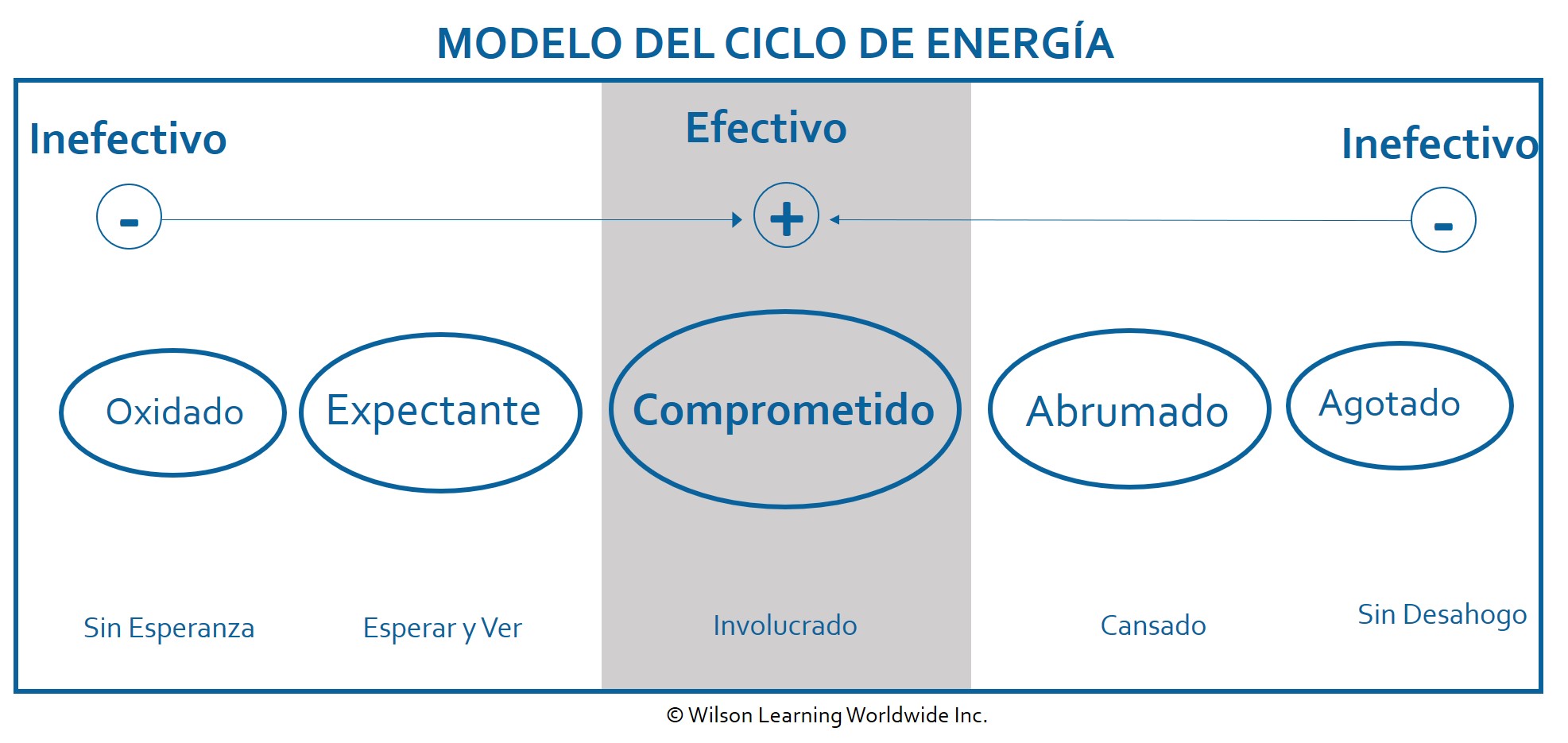
Hemos ilustrado lo que puede sucederles a los empleados que experimentan cambios en todas las formas, tamaños y velocidades en el Continuo de Energía:
Permanecer comprometido es el punto óptimo del continuo; cuando los empleados están comprometidos, la efectividad está en su punto máximo y el compromiso es alto. Para que cualquier iniciativa de cambio se ejecute y tenga éxito, la mayoría de la fuerza laboral debe participar.
Cuando el cambio frecuente lleva a los empleados a sentirse abrumados, la energía fluye hacia la derecha del centro en el continuo. Esto puede suceder por varias razones, a menudo cuando los empleados sienten que han perdido el control de su "yo". Si las condiciones que llevaron a esta sensación no se corrigen, los empleados pueden comenzar a sentir agotamiento ocupacional. Los empleados pueden concluir que simplemente no pueden dar más energía, lo que lleva a la desconexión.
El flujo de energía hacia la izquierda en el continuo ocurre cuando los empleados ponen su energía en espera. Cuando ponen su energía en espera, se desconectan. Sí, dedican su tiempo, pero no su energía positiva y discrecional. El desencadenante principal de esto es la percepción de pérdida debido al cambio, sólo superada por la fatiga. La oxidación ocurre cuando los empleados se desconectan psicológicamente de la organización. No pueden esperar hasta el final de la jornada laboral y cualquier energía que tengan permanece sin descubrir.
Liderazgo Tóxico
Cuando la toxicidad se filtra en el lugar de trabajo desde el liderazgo de la organización, produce factores poderosos que conducen a la desconexión de los empleados. Cuando un empleado siente que su jefe es tóxico y está agotando la energía (eche un vistazo al Continuo de Energía), puede imaginar que incluso la energía de los empleados más comprometidos se drena hacia la izquierda o derecha del centro en el continuo.
Las prácticas de liderazgo tóxico pueden ocurrir cuando no se reconoce o recompensa el desempeño bueno o excepcional, o cuando no se aborda el bajo desempeño de un compañero de trabajo. Producen un entorno en el que los empleados creen que no están involucrados o informados, o se sienten sin apoyo, sin ser escuchados o sin valor. Cuando los empleados creen que a su gerente no le importan, los puntajes de compromiso de los empleados comienzan a descender por una pendiente resbaladiza.
Antes de llegar al antídoto contra el liderazgo tóxico, demos un paso atrás y revisemos lo que significa la participación de los empleados.
¿Qué es Compromiso Emocional?
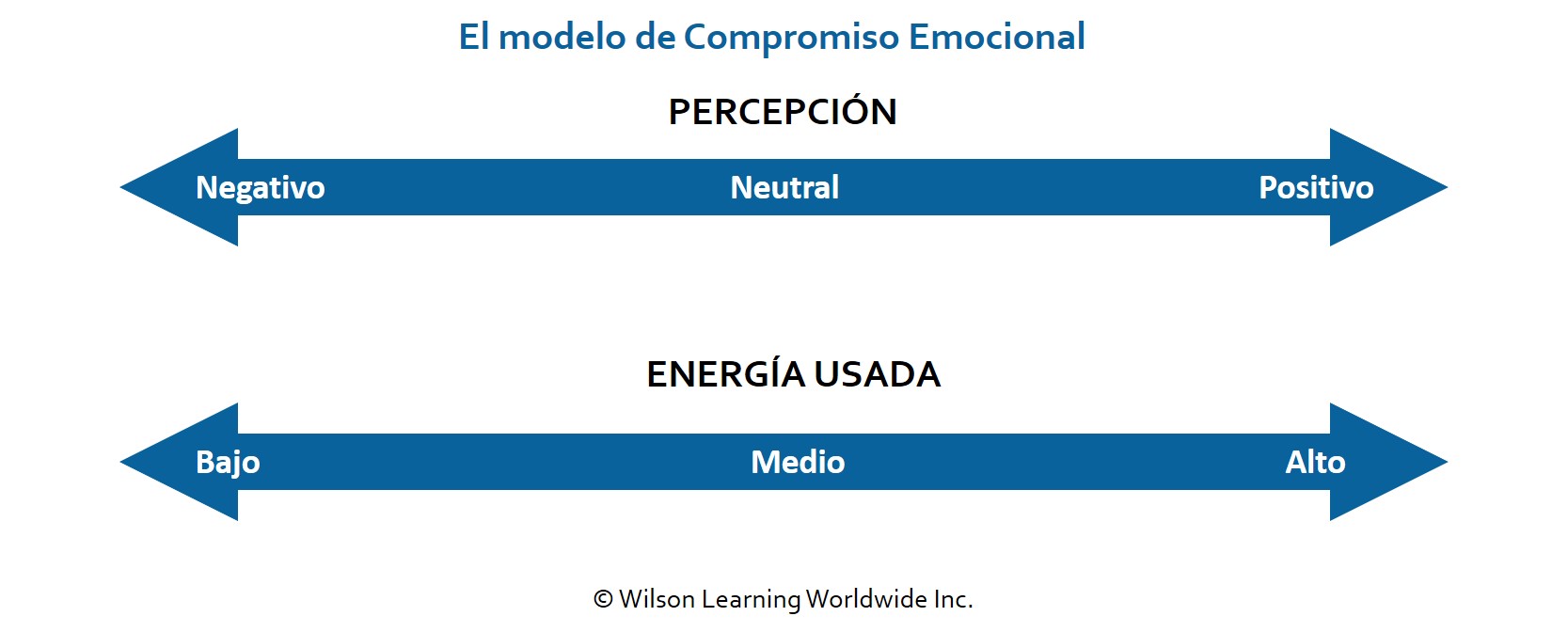
Si podemos compartir una comprensión clara de cómo se ve un empleado comprometido, podemos comprender mejor en qué deben centrarse los líderes para reactivar una cultura que respalde el compromiso total.
Los empleados, consciente o inconscientemente, eligen su nivel de compromiso. Esto puede decidirse en función de su percepción del cambio, o por la solicitud que se les haga y cuánta energía o esfuerzo creen que deberían invertir en esa solicitud. Un empleado comprometido elige una percepción positiva y proporciona una alta energía discrecional. Vale la pena señalar que ésta es una elección que hace un empleado.
El Modelo de Elección
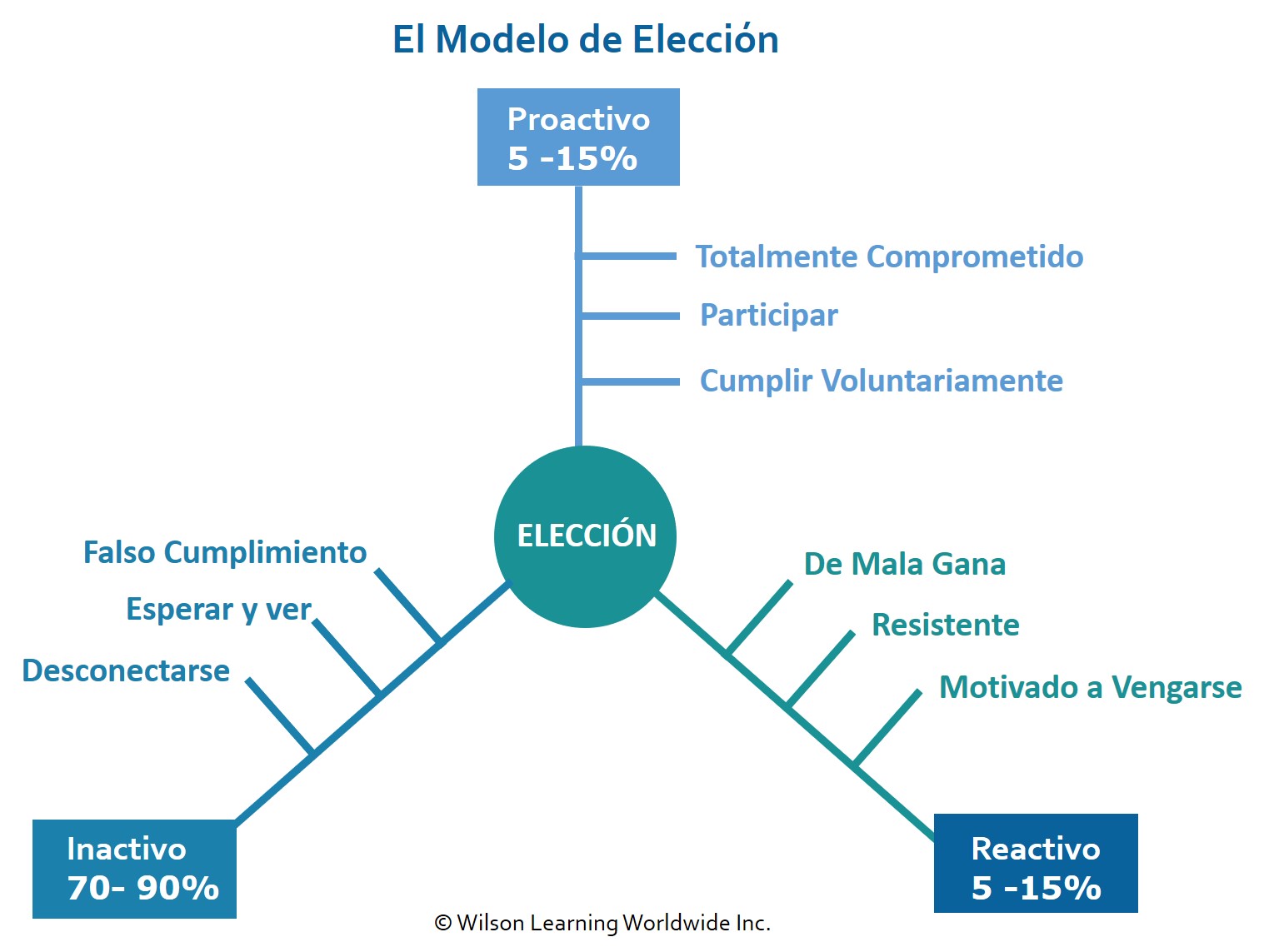
Al determinar cómo usar su energía, las personas pueden elegir ser proactivas, reactivas o inactivas.
Los empleados "proactivos" eligen gastar energía de manera positiva. Los diversos grados de cómo se demuestra eso se pueden describir como cumplir voluntariamente, participar y estar totalmente comprometido.
Los empleados "reactivos" eligen usar su energía para oponerse o argumentar en contra del cambio. Nuevamente, hay tres grados diferentes: de mala gana, resistente y motivado a vengarse.
La elección de estar "inactivo" es una forma de desconexión. Ocurre cuando un empleado elige retener su energía o estar en un período de espera. Los tres grados de inactividad son falso cumplimiento, esperar y ver y desconectarse.
Nuestra investigación muestra que hasta el 80% de los empleados residen en este espacio inactivo. Aquí es donde la energía podría estar drenándose. Si está tratando de ejecutar alguna iniciativa de cambio, ya sea una estrategia nueva, una visión sólida o un plan bien pensado, si el 80% de sus empleados están inactivos y esperan en la maleza para ver qué puede pasar a continuación, el cambio simplemente no sucederá.
Eso es un dilema. Y, si ése es el caso, ¿qué tipo de liderazgo influye en las elecciones de los empleados? Preguntamos. Encuestamos a miles de personas en muchas organizaciones globales y preguntamos: "¿Qué se necesitaría para que usted permanezca comprometido o se vuelva a comprometer?" La respuesta principal fue: "El ejemplo del líder”
Si los líderes pueden actuar como grifos y verter energía en la organización o actuar como desagües y extraer energía, ¿qué tipo de liderazgo entiende lo que significa dar energía en lugar de quitarla?
Liderando tanto con la Esencia como con la Forma
Un liderazgo efectivo que apoya una cultura de compromiso total requiere el desarrollo de la Esencia y la Forma del liderazgo.
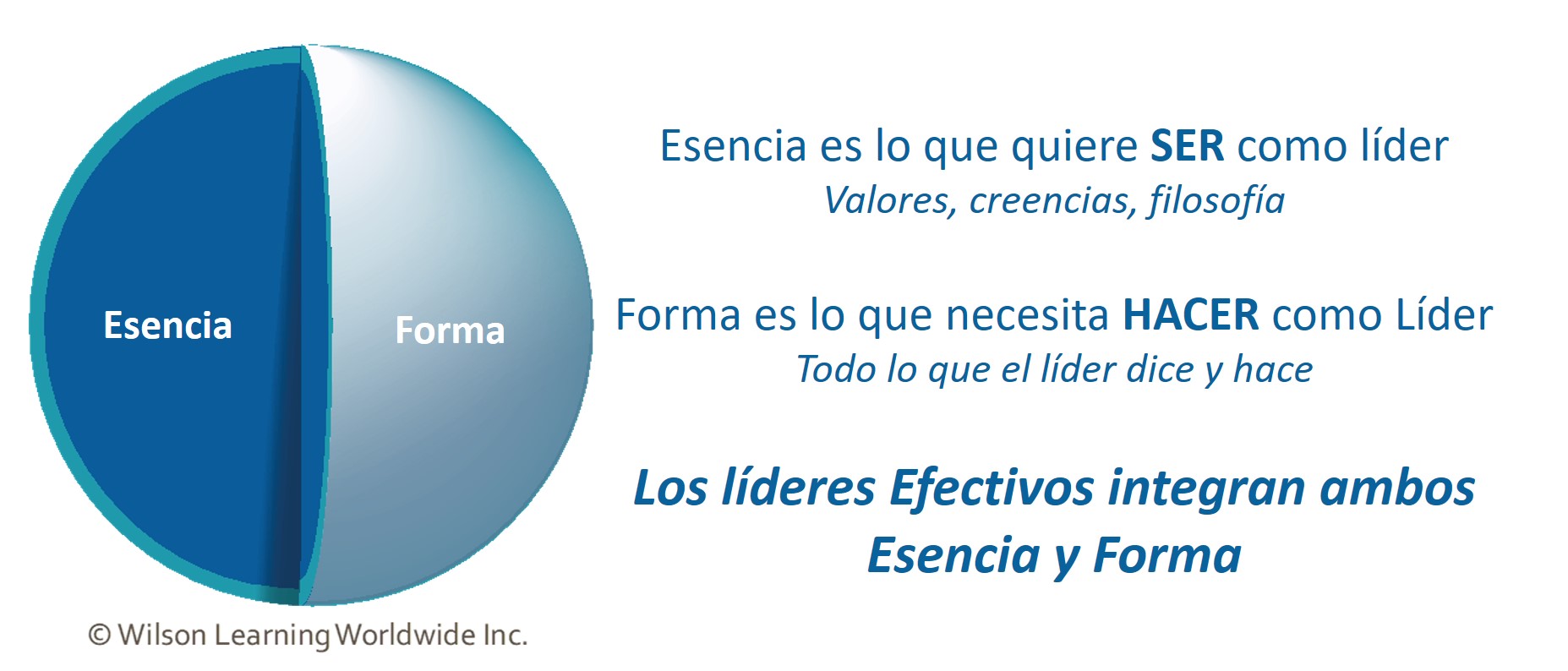
Los líderes desarrollan su esencia al aclarar su propósito para ser un líder y su filosofía, creencias y valores de liderazgo. En esencia, la esencia es la calidad de ser un líder. La forma es lo que un líder dice o hace. Representa aquellas decisiones, acciones y comportamientos que demuestran la Esencia del líder. Los líderes altamente efectivos y respetados son intencionales, sabiendo lo que quieren SER como líderes. Esto da forma a lo que necesitan HACER como líderes, haciendo de la Esencia (el carácter) la base sobre la cual se desarrollan sus Forma (habilidades).
Para impulsar genuina y efectivamente una cultura de compromiso complete, los líderes deben comprender que el ejemplo que dan influirá enormemente en cómo los empleados eligen comprometerse.
Si los líderes actúan con base señales de fuentes externas, como la influencia de otras personas, y miden su éxito por su título, posición o apariencia, confían en la "aprobación" de los demás y carecen de profundidad en sus propios valores internos. O si, por otro lado, los líderes se enfocan en señales internas, como sus valores y creencias inquebrantables, y miden su éxito por la efectividad y la contribución de los demás, viven su vida con “propósito”
Recuperación de Energía: Volver a Comprometer a la Organización
La fuerza catalizadora detrás de la recuperación del compromiso emocional de los colaboradores proviene de cinco elementos que influyen directamente en las dos dimensiones del compromiso: la percepción y la energía invertida. Estos elementos influyen en las elecciones que hacen los empleados, lo que lleva a un alto compromiso.
Creando una Cultura de Compromiso Emocional: Cinco Elementos
- Oportunidad Percibida
- Responsabilidad (Accountability) Personal
- Conectividad
- Inclusión
- Validación
Las empresas con empleados comprometidos ven la cultura como una causa más que como un efecto, y se espera que los líderes asuman la responsabilidad de crear una cultura que facilite la participación de los empleados. Comienzan enfocándose en estos cinco elementos y toman las siguientes acciones clave.
1. Oportunidad Percibida
El compromiso ocurre cuando las personas sienten que son parte de algo importante y tienen algo en lo que creer.
Los empleados quieren entender lo que depara el futuro y quieren tener una sensación de esperanza. ¿Por qué pueden emocionarse en el futuro? Sin una sensación de oportunidad futura para avanzar, vivirán en la pérdida en lugar de pasar por ella.
Acciones Clave que los líderes pueden tomar:
- Centrarse en crear el potencial para la organización: optimismo realista.
- Comunicar la visión, misión y estrategia de la organización en el contexto de oportunidad y potencial.
- Explicar cómo las personas aportan valor a la capacidad de la organización para realizar su potencial.
2. Responsabilidad (Accountability) Personal
El compromiso ocurre cuando se espera que las personas den lo mejor de sí y sepan de qué se les hace responsables. Cuando éste es el caso, aumenta la responsabilidad personal.
Los empleados quieren que se respondan sus preguntas: “Como resultado de los cambios, ¿qué esperan de nosotros? ¿Cómo seremos responsables?” Los empleados quieren saber cómo les afectará el cambio y qué esperan los líderes de ellos.
Acciones Clave que los Líderes pueden tomar:
- Asegurarse de que las metas de desempeño y las expectativas de comportamiento sean claras.
- Expresar abiertamente las expectativas: responsabilizar a las personas.
- Aclarar de qué serán responsables personas para que puedan hacerse responsables personalmente.
3. Conectividad
El compromiso ocurre cuando las personas se sienten conectadas entre sí, se centran en el interés mutuo y operan con responsabilidad compartida.
Los empleados quieren sentirse conectados entre sí. Quieren sentir que son parte de un entorno colaborativo, apoyándose mutuamente.
Acciones Clave que los Líderes pueden tomar:
- El compromiso se sustenta en la confianza y el apoyo de colegas.
- Facilitar un alto nivel de conexión entre las personas.
- Fomentar una mentalidad de colaboración basada en el interés mutuo y la responsabilidad compartida.
4. Inclusión
El compromiso ocurre cuando las personas están bien informadas, involucradas y tienen la oportunidad de expresar abiertamente sus pensamientos y sentimientos. En pocas palabras, la gente quiere sentirse "dentro" de las cosas.
Los empleados quieren sentirse incluidos. Quieren participar en la autoría del futuro. Todos los aspectos de la comunicación entran en juego: una mayor comunicación, la oportunidad de brindar aportes, la oportunidad de discutir problemas y hacer preguntas, y la oportunidad de ser escuchado e involucrado.
Acciones Clave que los Líderes pueden tomar:
- La inclusión crea naturalmente compromiso. La inhibición de la comunicación crea, naturalmente, la desconexión.
- Establecer sistemas que garanticen que la información siempre fluya y que las personas estén informadas.
- El factor más importante para compartir información es tener una cultura de confianza.
5. Validación
El compromiso ocurre cuando las personas sienten que realmente importan, que tienen un lugar valioso en la organización.
Los empleados quieren que los líderes se preocupen por ellos. Quieren sentir que son una parte importante del futuro de la organización y quieren ser apoyados, reconocidos y desarrollados.
Acciones Clave que los Líderes pueden tomar:
- Asegurarse de que existan sistemas y procesos para recompensar, apoyar y desarrollar a las personas.
- Mostrar interés en las personas al apoyarlas, recompensarlas y desarrollarlas personalmente.
- Asegurarse de que las personas no abandonen la organización porque sienten que no importan.
¿Está ayudando a sus líderes a tomar medidas para implementar los elementos del compromiso emocional?
Estos cinco elementos dan forma y fomentan una cultura de compromiso. ¿Cómo se muestra el compromiso emocional en su organización?
Para obtener más información acerca de los conceptos compartidos en este artículo y cómo Wilson Learning puede ayudar a abordar estos problemas, contacte a Wilson Learning en México al 52(55)56608360, en Colombia al 57(1)2138896, en Chile al 56 2.29516806, en Ecuador al 5932.4508283 y en Brasil al 5511.30422925.





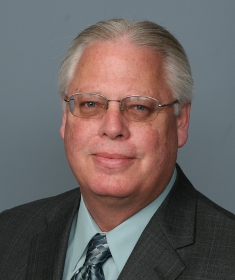

 Por favor, complete este formulario para descargar El Liderazgo como la Fuerza Catalizadora detrás de la Recuperación del Compromiso Emocional de los Colaboradores | Recreando una Cultura de Compromiso Emocional.
Por favor, complete este formulario para descargar El Liderazgo como la Fuerza Catalizadora detrás de la Recuperación del Compromiso Emocional de los Colaboradores | Recreando una Cultura de Compromiso Emocional.



